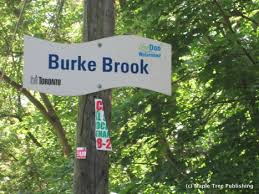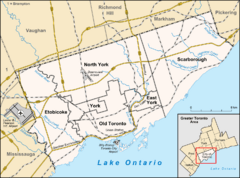Burke Brook facts for kids
Quick facts for kids Burke Brook |
|
|---|---|
 |
|
|
Location of the mouth of the creek in Toronto
|
|
| Country | Canada |
| State | Ontario |
| Region | Greater Toronto Area |
| City | Toronto |
| Physical characteristics | |
| Main source | Glenview Senior Public School, Canada 178 m (584 ft) 43°43′14″N 79°24′29″W / 43.720583°N 79.408013°W |
| River mouth | Don River Sunnybrook Park, Canada 134 m (440 ft) 43°43′14″N 79°21′56″W / 43.720586°N 79.365653°W |
| Length | 9 km (5.6 mi) |
| Basin features | |
| River system | Don River |
| Tributaries |
|
Burke Brook is a small stream in Toronto, Ontario. It is part of the Don River watershed. This is a major river that flows into Lake Ontario. The north end of Burke Brook starts near Glenview Senior Public School.
Contents
How Burke Brook Has Changed
Burke Brook used to begin near Downsview Airport. From there, the stream flowed southeast. It met the current starting point of the stream (east of Glenview Senior Public School). After that, the stream followed its path to the West Don River. The stream used to be about 9 kilometers (5.6 miles) long. About 6 kilometers (3.7 miles) of this length came from smaller streams joining it.
Streams That Join Burke Brook
A tributary is a smaller stream or river that flows into a larger one. Burke Brook has some interesting tributaries.
Havergal Stream
Havergal Stream flows entirely through the property of Havergal College. This is a school for girls. The stream starts from local sewers and nearby natural springs. Havergal Stream then meets the North Toronto Storm Trunk Sewer. This happens at the edge of the school property. The water from Havergal Stream flows into this sewer. The sewer then joins Burke Brook.
Havergal Stream used to start under the intersection of Old Orchard Grove and Barse Street. This was near the Baycrest Hospital. The stream was about 1.5 kilometers (0.9 miles) long. It flowed south-southeast to the current Havergal College grounds. Today, it appears from underground there. The stream then went to where the North Toronto Storm Trunk Sewer is now. It met Burke Brook a little east of that spot.
North Toronto Storm Trunk Sewer
The North Toronto Storm Trunk Sewer is a large underground pipe. It carries stormwater away in North York, Toronto, Ontario. This sewer has two main parts. One part starts at Lawrence Avenue and follows the old path of Burke Brook. The other part begins at Douglass Avenue and Bathurst Street.
This sewer was a big project for Metropolitan Toronto. It was built during the 1960s and 1970s. Like other sewers built at that time, it had a few goals. It helped reduce sewage along the planned route for the Spadina Expressway. It also helped separate sewage particles in smaller towns. This allowed more land to be used for building homes and businesses. The sewer also connects to the North York Storm Trunk Sewer. This connection is near Douglass Avenue and Bathurst Street. The North Toronto Storm Trunk Sewer meets Burke Brook near Glenview Senior Public School.
Streams That Used to Join Burke Brook
Burke Brook once had about 6 kilometers (3.7 miles) of smaller streams flowing into it.
Blythwood Stream
Blythwood Stream started near Glengowan Road and Strathgowan. It also began at Saint Leonards Avenue and Saint Ives Avenue. This stream was the closest tributary to the Don River. The two parts of the stream joined at Strathgowan Road and Fidelia Avenue. The stream then flowed just east of Blythdale Road. It ran almost parallel to the road until it met Burke Brook. This stream was about 1 kilometer (0.6 miles) long.
Lawrence Park Stream
Lawrence Park Stream joined with the McDougall Stream. This meeting point was near the Locke Library. The Lawrence Park stream was about 6 kilometers (3.7 miles) long. The McDougall Stream was about 1 kilometer (0.6 miles) long. Lawrence Park Stream started near Wilson Avenue and Avenue Road. It then flowed to where it met the McDougall Stream. After that, it continued east of Yonge Street. It met Burke Brook near Yonge Street and Saint Edmunds Drive. The McDougall Stream started just north of the Blythwood Stream. It curved north and west to meet the Lawrence Park Stream.
Parks Along Burke Brook
Many parks are located along Burke Brook. They are listed here from east to west.
Sunnybrook Park
Sunnybrook Park is a large park in Toronto. It connects to the Don Valley from the west. This park is home to the Sunnybrook Stables. It also has dog parks and many sports fields. You can find many bike and walking paths here. There are also a few roads for cars. The park is well-known for its cricket games.
Burke Brook Ravine
The Burke Brook Ravine is a natural valley. It stretches from Sunnybrook Park to Bayview Avenue. There isn't an official path connecting it to Bayview Avenue. However, you can reach it from Bayview Avenue using steep, sloped paths.
Sunnydene Park
Sunnydene Park is a small park. It is just east of Sherwood Park. It is also west of Bayview Avenue. This park is very close to Sherwood Park. Some maps even show it as part of Sherwood Park.
Sherwood Park
Sherwood Park is another park in Toronto. It has a city maintenance building. There is also a water park, a playground, and washrooms. The park has two paths, one on each side of Burke Brook. It includes a dog-off-leash area to the southeast. This area is north of the Mount Hope Catholic Cemetery. It is also west of Sunnydene Park. To the north of the park is Blythwood Road and the Blythwood Ravine. A road leads west out of the park to Sherwood Avenue.
Blythwood Ravine Park
Blythwood Ravine Park is a natural area. It is located between Alexander Muir Memorial Gardens and Blythwood Road. You can also enter it from the ends of Strathgowan Avenue and Glengowan Road. This park is quite narrow. It acts as a connecting park between Sherwood Park and Alexander Muir Memorial Gardens/Yonge Street.
Alexander Muir Memorial Gardens
This park is between Blythwood Ravine Park and Yonge Street. It has tennis courts for the Lawrence Park Tennis Club. It also has fields for the Lawrence Park Lawn Bowling and Croquet Club. A special feature of the park is a stone wall. On this wall, you can find the words to "The Maple Leaf Forever." This is a patriotic song about Canada by Alexander Muir. Stairs connect the wall to the park's fields and gardens.
The park was first located on the west side of Yonge Street. It was across from the Mount Pleasant Cemetery. It was built to celebrate Toronto's 100th birthday. To build the Yonge Subway, the TTC moved the park. They paid over $100,000 to move it, including the stone wall. It was moved to its current spot in Lawrence Park.
Duplex Parkette (and Glenview Parkette)
In Duplex Parkette, Burke Brook flows underground in pipes. Glenview Parkette has two small green areas. Pathways run through these areas.
Chatsworth Ravine
Chatsworth is a ravine between Duplex Avenue and Glenview Senior Public School. It has a path that goes to Cheritan Avenue. There is a bridge in the middle of the ravine. This bridge moves the path from the south side of the stream to the north side.
How to Cross Burke Brook
Here are the street crossings over Burke Brook, listed from east to west:
- Bayview Avenue - There are no traffic or pedestrian lights here. Kilgour Road has the closest Traffic light.
- Blythwood Road - This crossing has pedestrian crossing lights.
- Mount Pleasant Road - The path goes under a bridge here.
- Yonge Street - There are no traffic or pedestrian lights at this crossing. Saint Edmunds Drive has the closest traffic lights.
- Duplex Avenue - There are no traffic lights here. Glenview Avenue has the closest pedestrian crossings, marked by a stop sign.




